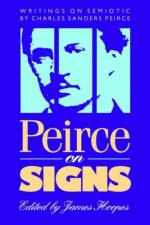|
This section contains 6,146 words (approx. 21 pages at 300 words per page) |

|
SOURCE: "Reflections on Peirce's Aesthetics," in The Monist, Vol. 65, No. 2, April, 1982, pp. 143-55.
In the following excerpt, Kaelin defends Peirce's aesthetics as an uncredited source of modern critical theory.
I
The first thing to note about Peirce's semiotic aesthetics is that Peirce himself had very little to say about it. Two articles published in the Journal of Asthetics and Art Criticism are concerned with determining Peirce's views on aesthetic theory. The first was by Max Oliver Hocutt, in 1962, called "The Logical Foundations of Peirce's Aesthetics."1 This article has something less than an auspicious start, however, since its first sentence reads, "There is a sense in which it might be said that Charles Peirce had no aesthetics."2 And since that sentence is followed in the next paragraph with one of the flattest—or, if you prefer, deadest of metaphors, to wit:
Probably the best single explanation of this fact...
|
This section contains 6,146 words (approx. 21 pages at 300 words per page) |

|


